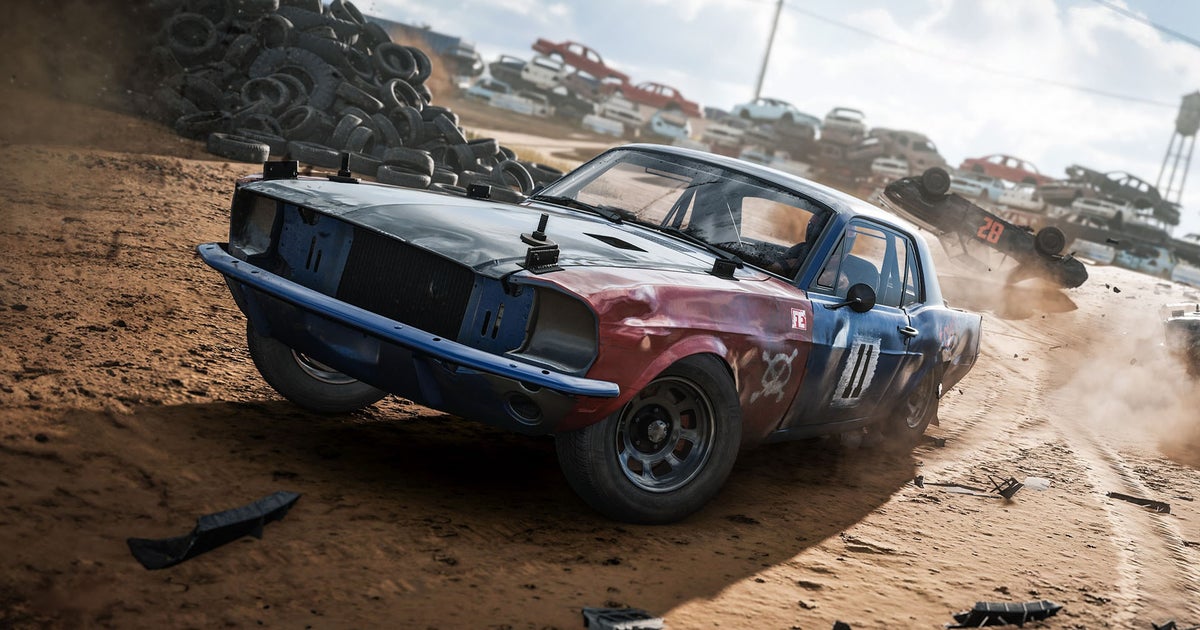Going on seven years now, Wreckfest has carved out a space for itself as a technically ambitious racing game built around robust soft-body physics simulation. This year, the long-awaited sequel has finally launched in early access on PC. While Wreckfest 2 is still very much a work in progress, it already makes a strong case for itself, not just as a worthy follow-up, but as a showcase for some of the most advanced real-time physics we’ve seen in the genre.
The current early access release is exclusive to PC, but the final game is set to arrive on consoles as well. The present build contains just a handful of tracks, with both online and offline racing supported. Like the original, it’s being developed by Bugbear Entertainment of Ridge Racer Unbounded fame.
Wreckfest 2 is defined by its physics, which has been completely rebuilt to take advantage of modern hardware and runs as part of Bugbear’s in-house ROMU engine. It boasts a fully dynamic simulation system that runs in real time across all vehicles, debris, and environmental elements. Currently, the game supports up to 24 cars in a single race, ensuring sufficient chaos to really demonstrate the possibilities of such a simulation.
When you first begin a race at the back of the pack, it’s honestly amazing to watch everything unfurl before you. From the car’s suspension to the plethora of objects scattered across the environment to the realistic damage and crumble zones, it really does exhibit a level of fidelity that I’ve never seen in a racing game. Panels twist and shear based on contact angle and force; suspensions buckle under strain. Even minor impacts can have visible mechanical consequences that make it harder to stay on the road. Crucially, none of it is pre-calculated – it’s all properly simulated. When another car smashes into you, they seem to deploy a mix of materials and mesh damage. Paint is scraped away, revealing the metal beneath, but the actual individual pieces can also crumble and change based on external forces.
What makes this so unique? Well, it comes down to the component-based approach the team has taken here. Essentially, as in real-life, every car in the game is actually created from individual pieces – body panels, the drive train itself and everything else under the hood is not only modeled but contains its own properties. They actually simulate material-specific properties too, with glass, plastic and steel all providing different levels of strength and rigidity. When you slam into another car, a lot of calculations need to happen – it’s not just two models colliding, it’s about the collection of parts which make up that car.
The driving physics themselves benefit from what feels like a greater focus on simulating the mass of the vehicle – tyres deform and chassis flex in a way that grounds each vehicle. Sliding around a corner while taking out an opponent feels amazing. Thanks to the focus on components, you can see the individual parts being wrecked reported in the corner of the screen. This damage directly impacts your ability to race, altering the handling in ways that require you to get a little creative.
To that end, the current build includes a physics playground packed with unusual attractions like crushers, stairs, loops and ramps that allow you to smash up your car and test the driving model in different ways.
Other tracks show further enhancements to the game’s visuals. They’re loaded with debris and physics driven objects such as tyres, shelving, old car parts and the like are everywhere – and nearly all of it reacts to the player. Watching a full grid of 24 cars smash through a garage never gets old.
The actual rendering quality is really a huge improvement over the prior game too, with tracks that sport an exceptionally high level of detail and even a level of atmospheric haze, making for a more realistic presentation than the last game. Looking at the Savolax Sandpit track shared between both games, you can get a better sense of how cars seem more rooted in the environment with ambient occlusion and direct shadowing, the specular lighting seems more natural and materials are markedly improved across the board. There are also more bespoke objects per track, helping each feel a bit more distinctive.
I love that Bugbear has opted to stick with its in-house technology rather than jumping to Unreal Engine like so many others. It lends the visuals unique character that I enjoy. There’s also some options available that you don’t often see these days, including MSAA as an anti-aliasing option, though the more commonplace FSR3 is also supported (but not DLSS just yet).
Aside from the visuals, there’s also the audio side of things. There’s no music in this early build, but there seems to be a focus on carefully separating sounds to ensure that everything happening in the race has an appropriate audio component – the perfect choice for the advanced physics on display.
Of course, being early access, we can’t really gauge performance just yet. I’m using a high-end RTX 5090 PC to play the game and I was able to hit a stable 4K 120fps with all visual settings maxed out, but how it scales to lower-end PCs isn’t yet clear. It does need to run on consoles, of course, and they’ve paid special attention to optimising the damage modeling to be fast and flexible, according to their blog post on the matter.
There’s plenty to be excited about here, and it’s fantastic to see how ambitious Bugbear continues to be in pushing the state-of-the-art when it comes to their trademark blend of driving and destruction. We’ll keep abreast of Wreckfest 2 as it matures, and hopefully we’ll be able to deliver the final verdict once it gets a full release – financial reports suggest publishers THQ Nordic are targeting the current financial year, which would see the game come out by March 2026.

